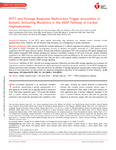POT1 and damage response malfunction trigger acquisition of somatic activating mutations in the VEGF pathway in cardiac angiosarcomas

Use este enlace para citar
http://hdl.handle.net/2183/23969
A non ser que se indique outra cousa, a licenza do ítem descríbese como Atribución-NoComercial 3.0 España
Coleccións
- Investigación (FCS) [1284]
Metadatos
Mostrar o rexistro completo do ítemTítulo
POT1 and damage response malfunction trigger acquisition of somatic activating mutations in the VEGF pathway in cardiac angiosarcomasAutor(es)
Data
2019-09-17Cita bibliográfica
Calvete O, García-Pavia P, Domínguez F, et al. POT1 and damage response malfunction trigger acquisition of somatic activating mutations in the VEGF pathway in cardiac angiosarcomas. J Am Heart Assoc. 2019;8(18):e012875
Resumo
[Abstract] Background
Mutations in the POT1 gene explain abnormally long telomeres and multiple tumors including cardiac angiosarcomas (CAS). However, the link between long telomeres and tumorigenesis is poorly understood.
Methods and Results
Here, we have studied the somatic landscape of 3 different angiosarcoma patients with mutations in the POT1 gene to further investigate this tumorigenesis process. In addition, the genetic landscape of 7 CAS patients without mutations in the POT1 gene has been studied. Patients with CAS and nonfunctional POT1 did not repress ATR (ataxia telangiectasia RAD3‐related)–dependent DNA damage signaling and showed a constitutive increase of cell cycle arrest and somatic activating mutations in the VEGF (vascular endothelial growth factor)/angiogenesis pathway (KDR gene). The same observation was made in POT1 mutation carriers with tumors different from CAS and also in CAS patients without mutations in the POT1 gene but with mutations in other genes involved in DNA damage signaling.
Conclusions
Inhibition of POT1 function and damage‐response malfunction activated DNA damage signaling and increased cell cycle arrest as well as interfered with apoptosis, which would permit acquisition of somatic mutations in the VEGF/angiogenesis pathway that drives tumor formation. Therapies based on the inhibition of damage signaling in asymptomatic carriers may diminish defects on cell cycle arrest and thus prevent the apoptosis deregulation that leads to the acquisition of driver mutations.
Palabras chave
Cardiac angiosarcoma
Cell cycle arrest
Damage response
POT1
VEGF/angiogenesis pathway
Cell cycle arrest
Damage response
POT1
VEGF/angiogenesis pathway
Versión do editor
Dereitos
Atribución-NoComercial 3.0 España
ISSN
2047-9980






